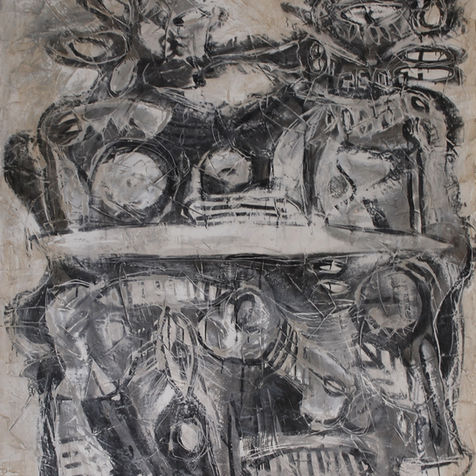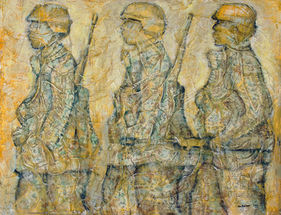
Early Works
(1969-1976)
During and after completing his studies at the Frankfurt Art School Westend (1969-1975), which he completed as a master student with Carlo Ruppert, Hans Nauheimer initially devoted himself primarily to hand-drawing in the style of Realism and experimental collage.


clic to enlarge
Already in his early work he has dealt socially critically with topics such as the military, "Violence of the conflict" and the "transience of human bodies". These will stay main topics along his whole artistic life.


Surreal fantasy
(1976-1979)
In 1976 Nauheimer stopped drawing. The occasion was the criticism of a humanist, he showed in his pictures no solutions and ways out but confront viewers too much with the realism.
"I made edible collages of chocolate chips, wafers, glitter and mica. I painted what I had glued.", said Hans Nauheimer.
This phase became more concrete in 1979. He created pictures with lush ornamentation and impressive decorations, occasionally enriched with figuratives. These early works were characterized by surreal fantasy.

clic on the pictures to enlarge

Pattern painting
(1979-1982)
The 70s are today regarded as an epoch of crises, upheavals and changes. The end of the long post-war boom in the economy, the oil price crises, the assassination of Israeli athletes during the 1972 Olympic Games in Munich, the end of the Vietnam War and the terror of the RAF, the so-called "German autumn". This era also reflected in art. It was the search for new artistic content, the radical criticism and questioning of the social, political and artistic system.
Parallel to this Zeitgeist, Nauheimer's works were characterized by works with symbolism and patterns. In this period emerged, similar to the Pop Art oriented american pattern painting, underlined patterns which became independent as graphic elements to the abstracted character.

I deliberately left the composition and turned to the american art form Pattern Painting.
Hans Nauheimer
True to the "pattern painting principle", Hans Nauheimer painted wallpaper-like pattern images based on American Pop Art until the mid-1980s.


Radical change
(1983-1989)
This period was strongly influenced by political, artistic and social currents. People rebelled against existing art styles and deliberately opposed established painting. A social minority that strongly inspired the art scene of the 80s were the homosexuals, above all Warhol and Keith Haring.
In the mid-1980s, Nauheimer radically broke away from "pattern art" in favor of strong colors with expressive language. He produced large-format paintings that are strongly reminiscent of Jackson Pollock's action paintings, but which contain the discipline of structure, rhythm, and colorfulness of "pattern painting."
This detachment from established painting is evident in Nauheimer's large-format paintings at the end of the 1980s, which are reminiscent of "Pollock's Action Paintings" but incorporate the structure, rhythm, and color of "Pattern Painting."

110 cm x 121 cm Acryl auf Leinwand

90 cm x 121 cm Acryl auf Leinwand

120 cm x 121 cm Acryl auf Leinwand

36,5 cm x 50,5 cm Acrylic on wood
In the 90s, Nauheimer continued along this path: fierce exploration of forms and colors and also the use of collage elements, which in his works also show the transience of all life.

In the past, I destroyed my paintings, poured paint on them, drove over them with a car, burned them, and filled the ashes. I still keep them.
Hans Nauheimer
Nauheimer evaluates this period of his artistic life thoughtfully:
"I painted a picture, photographed it, painted over the photograph a few times, and photographed it again. Finally, I doused the painting in turpentine in the garden and set it on fire. I collected the ashes and stored them in a bag."

100 cm x 121 cm Mischtechnik auf Leinwand

100 cm x 125 cm Acryl auf Leinwand

100 cm x 121 cm Mischtechnik auf Leinwand

100 cm x 131 cm Mischtechnik auf Leinwand

Colourful
Moods
(1990-1992)
Early 90's Nauheimer continued on this path of violent confrontation with shapes and colors. The works in this period reminiscent of colorful spots, which ia. symbolize the foliage of trees and key experiences. This was an evolution of his Pattern and Painting technique.

His work is characterized by strongly coloured, associative symbolism on the canvas.
Without subject binding, the eyes can better comprehend emotional things
Hans Nauheimer

129 cm x 190 cm Acryl auf Leinwand

190 cm x 129 cm Acryl auf Leinwand

Primitivism
(1993-1999)
The 1990s were marked by the reorganization of the world after the end of the "Cold War" and the collapse of the communist Eastern Bloc states. The art of the 90s stands between departure and longing. Characteristic is no longer the production of things but the processing of symbols, data, words, images and sounds. There is a crossover of fashion and art.
For Nauheimer this is the time of archaic, monochrome, plaster-like pictures, whose monumental effect sought a certain primitivism. Life and death, the relationship of man to his environment in general, the polarity of the sexes in particular, are objects of the painter's paintings reminiscent of cave paintings.

This stage of Hans Nauheimer's artistic development from the 1990s onwards represents his involvement with plastic plaster masses. In layers, these are glazed, then sanded, worked on with a chisel and glazed again, and again filled, sanded and glazed. Nauheimer wants to create a diffuse character.

He created 20 to 30 pound works in delicate pastel tones. The motifs are carved into the unevenly applied background material rather than painted on. The motifs are stylistically influenced by ancient cultures from the Stone Age through antiquity to the Middle Ages. They are archaic, plaster-like images with monumental effect.

The late 90s were also the years of his plaster paintings and spatial installations made of plaster. It should be noted here a triptych: a three-part panel with 450 plastic bananas wrapped by hand with plaster bandages. In front of it, he positions a white woman with a roundish figure, who throws her head back lustfully with a halo also made of bananas. The 3-part altarpiece is accompanied on the right and left by two votive flags with mask-like faces. At their feet, join two torsos with banana crowns. The whole is framed by individual small figures.




Lying on wooden plate fixed plaster figure with canvas background on a substructure on wood. Height: 55 cm/ Width: 91 cm / Length: 110 cm

"Nauheimer titles his nameless work "All in White. He speaks of alienation. The bananas have lost their actual function as food. Through the room installation they experience an exaggeration.
The banana triptych is meant to symbolize strength and vitality. Nauheimer uses the word "life-giver".
The artist worked for about 4 months on his work, which was born out of a flash of inspiration.

Late Paintings
(2000-2010)
The mood of the 1990s finally came to an end on September 11, 2001, when "9/11" dealt a severe blow to the optimism and boundless belief in the future of capitalism.

In 2010 the artist Hans Nauheimer ended his great creative period. In 2011 and 2012, smaller pencil drawings were made.




















